

THE BUTTERFLIES OF BRITISH COLUMBIA
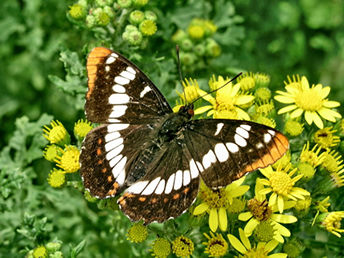
Lorquin's Admiral (Limenitis lorquini), photo by Gary Ansell
Introduction to the Butterflies
by
Crispin Guppy
Click here for a 2008 list of the Lepidoptera of BC Click here to read the general introduction to the Lepidoptera Click here to look up any butterfly species in North America |
Butterflies have been likened to flowers that fly and are among the most beautiful and fascinating of animals in nature. They are found everywhere in British Columbia, from balcony planter boxes in the city to coastal bogs and wild ocean shorelines, alpine flower meadows of the coastal mountains, deserts of the southern interior, grasslands of the the Chilcotin, and the vast unexplored expanses of boreal forest and mountains across the north. Although the butterfly species found in British Columbia represent only a small fraction of the world’s 15,000 to 20,000 species, they can still provide a lifetime of study. Observation of the complex behaviours and life histories of each butterfly species within its own unique habitat can provide years of enjoyment for the butterfly enthusiast.
The term butterfly is normally used to mean both true butterflies, in the superfamily Papilionoidea, and the other major group of day-flying Lepidoptera, the skippers, in the superfamily Hesperioidea. There were 187 species and 77 subspecies of butterflies and skippers known from British Columbia by year 2000, for a total of 264 resident or immigrant subspecies. Of these, 4 are nonbreeding immigrants and 4 are immigrants that regularly breed within BC. The total butterfly fauna of BC should eventually reach at least 192 species and perhaps 196 species. The total known fauna of 187 species of butterflies is by far the largest in Canada.
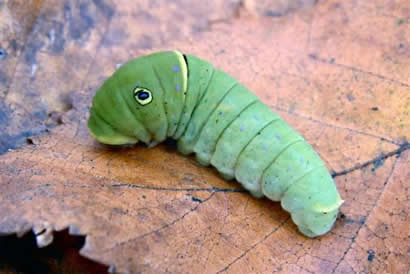
Canadian Swallowtail caterpiller (Papilio canadensis), photo by Cris Guppy
Butterfly Conservation
Butterfly conservation in BC has only recently been considered, with Guppy et al. (1994) first summarizing the known status of butterflies of conservation concern in the province. Since then, a number of national conservation status reports for BC butterfly species have been completed for the national Committee on the Status of Wildlife in Canada (COSEWIC), by Jon Shepard, Norbert Kondla and Crispin Guppy. NatureServe has completed global conservation status rankings for most North American butterflies, and the BC Ministry of Environment, Lands and Parks, in co-operation with NatureServe, lists BC provincial rankings. These rankings are periodically updated as a result of new information.
Legislation
It must be emphasised that legislation designed to protect butterflies from being collected, although fashionable and “feel-good,” will not by itself protect any butterfly species from extirpation or extinction. The first butterfly to be legally protected from collection was the Apollo, Parnassius apollo, in Germany in 1913. That protection, and subsequent protection from collection of other species in Europe, the US, and elsewhere has only been a last desperate attempt to conserve butterflies that have been driven to the edge of extinction by habitat destruction. The Apollo is now nearly extirpated from Germany despite 87 years of protection from collection, because the real source of its population decline was, and is, lack of habitat protection. Only through protection and appropriate management of the habitat of butterflies, sometimes supported by management of collecting, will the goal of butterfly conservation be achieved.
More than 35 years after the passage of the U.S.A. Endangered Species Act, and 87 years after the first European butterfly was protected, Canada has no equivalent federal legislation. The Canadian Species at Risk Act (SARA) of 2003 does little to protect endangered butterflies and other invertebrates, because it applies only to federally owned land (generally Indian Reserves, National Parks, and military reserves), fish, and migratory birds. The BC government has declined to introduce a BC Endangered Species Act; hence the habitat of rare butterflies is protected only in parks.
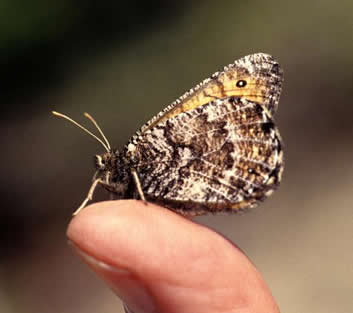
Chryxus Arctic (Oeneis chryxus), photo by Ian Lane
Habitat Loss
Habitat loss is the most critical threat to butterflies. Many species have a very limited natural range in BC because they require specialised habitats that are of limited extent in the province. The use of land for residential, industrial, forestry, agricultural, hydroelectric, and recreational purposes alters or destroys the natural habitats upon which butterflies depend. Unfortunately much of the most desirable and useful land in BC from the human perspective consists of the small, specialised habitats that are the sole homes of many of our butterflies.
Pesticides
Spraying with herbicides to kill weeds , and insecticides to kill insects, is inevitably detrimental to butterfly populations. Most spraying with chemical pesticides is now localised, and will affect only very local populations of butterflies. Hence, the pesticide that poses the most serious threat to butterfly conservation is the otherwise environmentally neutral bacterial insecticide Bacillus thuringiensis variety kurstaki, commonly known as Btk. It is frequently sprayed over thousands of hectares. Btk kills the larvae of all butterflies and moths, although some species are partially resistant to its effects. Any larvae feeding on the outside of leaves, which includes most butterfly larvae, will be affected when Btk is sprayed. Adult butterflies are not affected by spraying with commercial preparations of Btk.
The greatest impact of Btk is on the caterpillars of rare species; they may be completely eliminated from an area treated with Btk. Butterflies and moths of conservation concern are generally poor colonisers, and if there are no nearby populations from which recolonization can occur, they will have been extirpated forever. Controlling Gypsy Moths through Btk spray programs will therefore inevitably have a severe impact on, and likely extirpate, many of the butterflies and moths of conservation concern on southern Vancouver Island and the southern interior. The process may take decades, but it will probably be inexorable if Btk spraying continues to be the control method of choice for pest Lepidoptera species.
Predators, Parasites, and Competitors
Introduced predators such as birds, especially house sparrows and starlings, and parasites that are introduced either deliberately for pest control or accidentally must have a significant impact on butterfly populations, but there has been little research to document this.
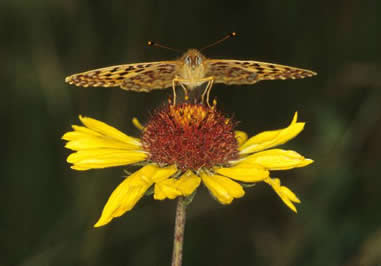
Zerene Fritillary (Speyeria zerene), photo by Ian Lane
Butterfly Collecting
Butterfly collecting is not extensive in BC, and never has been. There are fewer than five butterfly collectors residing in the province, and a similar number of moth collectors. There are very few non-resident collectors, most of whom collect only along the Alaska Highway on the way to the Yukon and Alaska. Collecting is usually done by amateur (unpaid) scientific collectors except for occasional government or university inventory projects. Almost all the information on the butterflies of BC has originated from these amateur collections over the past 150 years. Sight observations of butterflies, without collection of voucher specimens and their placement in a permanent collection, are of comparatively low value because of a high rate of identification error.
Scientific collection of voucher specimens (a few specimens collected to document the presence of a species) will have no adverse effect on the conservation status of the province’s butterfly species, and is the basis for documenting the presence, distribution, and number of butterfly populations. It is very difficult to damage a population through collecting, even when someone deliberately sets out to do so. Nearly all extinctions of butterfly populations in the United Kingdom, which has many butterfly collectors, have occurred in the absence of collecting (Thomas 1984).
The few extinctions that occurred during times of heavy collecting were of populations that were already on the brink of extinction due to habitat loss. Based on mark-release-recapture studies, it would take several collectors working every day for three weeks to extirpate a small (< 250 adults) lycaenid population (Thomas 1984). This is very unlikely to occur, especially if butterfly collectors follow guidelines similar to those of the Lepidopterists’ Society to ensure that their activities are conducted in an ethical manner. The Lepidopterists’ Society Web site, at http://www.lepsoc.org, includes a very large number of links to other butterfly- and moth-related sites.
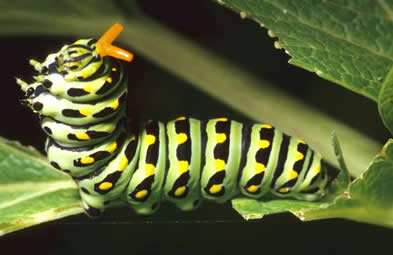
Anise Swallowtail caterpiller (Papilio zelicaon), photo by Ian Lane
Butterfly Photography
Many people would like to inventory butterflies without killing them. Reasons include personal ethics, lack of desire to collect, or inability to maintain a collection. Non-lethal inventory is possible for some species, but identifications are much more difficult and errors are difficult to correct later. A sight observation without documentation is of limited value because it is too easy, even for an expert, to make a mistake. Clear photographs are the only adequate substitute for specimens, and still will not replace specimens for some species. Photographs should show both the upper and lower sides of the wings. It is frequently necessary to capture a butterfly to obtain proper photographs. Photographs that are intended to be permanent records of butterfly observations should be fully labelled with the same collection data as for specimens, and should be maintained and eventually transferred to a public museum for permanent record.
Butterfly Counts
Annual butterfly counts occur in several areas of the province to track trends in population sizes of butterflies. Butterfly counts once or twice per year are useful for documentation of long-term general trends in populations averaged over a region, documentation of occurrences of migratory species, and location of new populations of rare species. Annual butterfly counts are co-ordinated by the North American Butterfly Association (NABA). The standard date for the count range varies slightly between years, but centres around 4 July. The count consists of recording the number of butterflies of each species seen within a circle 15 miles in diameter in one day. It is critical to include the number of “person-hours” of observation so that yearly changes in number of butterflies counted can be adjusted to account for the number of hours in which they were counted. For details, see the NABA Web site at http://www.NABA.org. Monthly or weekly butterfly counts can provide more valuable data than the single-day sampling, by including all species in an area and by accounting for some of the differences in flight periods between years.
Larval Foodplants
The larval foodplants of butterflies in BC are very poorly known, which will make future butterfly conservation efforts difficult. Before a habitat can be managed to enhance the foodplant of a rare species of butterfly, that foodplant must be known. Frequently, foodplants for BC butterflies are recorded from distant areas and may not even occur in the province. Local naturalists can add to our knowledge by providing detailed information about the foodplants associated with butterflies in the province. For example, when a larva is reared, the foodplant should be documented with a prepared plant specimen. The adult that emerges from the pupa should be prepared as a museum voucher specimen and eventually deposited in a public museum.
Butterflies in Schools
Butterflies are useful tools for teaching children and adults about insects. If done properly, collecting butterflies and other insects can teach much more than the name of a butterfly. Observations can be made on the different habitats each species uses, the different behaviours, the seasons each butterfly flies in, and how butterflies interact with each other and their environment. Collecting butterflies can provide a complete course in butterfly behaviour and ecology, and give students an opportunity to determine what species have been observed and how they vary in wing pattern. A student collection of only a handful of butterfly species can be the basis for many discussions about what those species do in the wild.
Butterflies can be readily bred in captivity, and are frequently reared in schools to teach students about their life cycle. Students find it fascinating to watch butterflies progress from eggs through caterpillars and pupae to adults that lay more eggs.
Please cite these pages as:
Author, date, page title. In: Klinkenberg, Brian. (Editor) 2021. E-Fauna BC: Electronic Atlas of the Fauna of British Columbia [www.efauna.bc.ca]. Lab for Advanced Spatial Analysis, Department of Geography, University of British Columbia, Vancouver. [Date Accessed]
© Copyright 2021 E-Fauna BC.